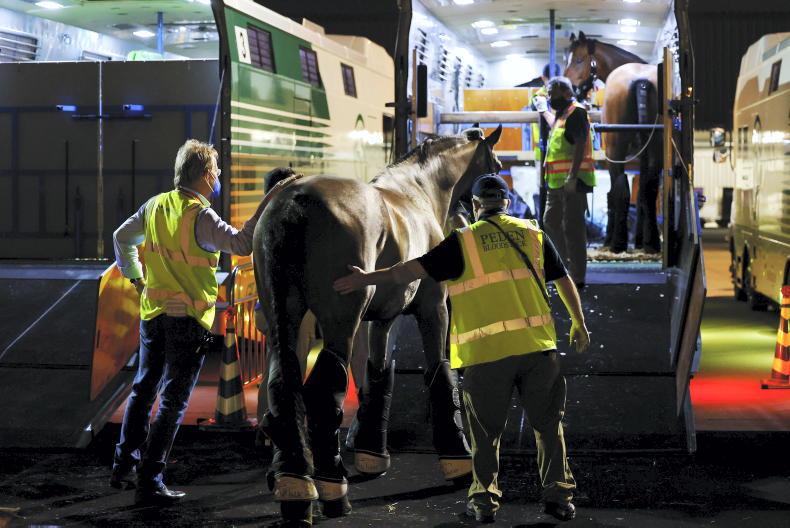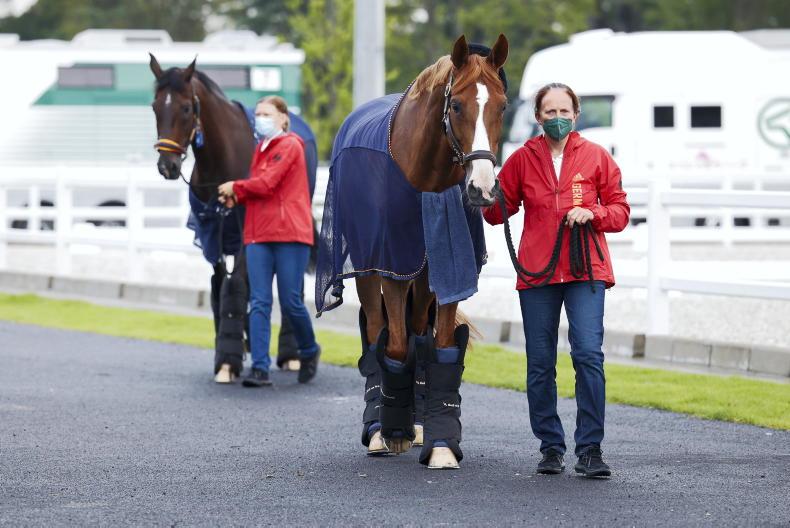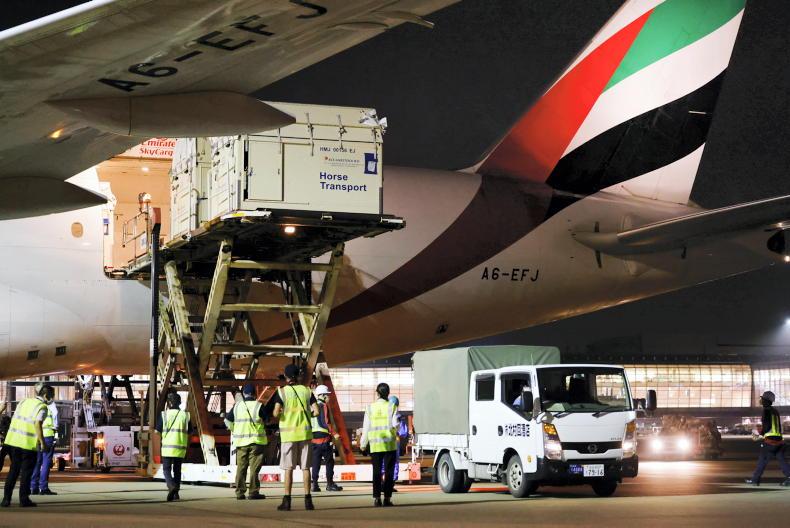A PIECE of history was made last night (Wednesday) when 36 horses flew into Japan – the first full cargo load of horses ever to land in Haneda, the waterfront airport that serves the greater Tokyo area and which is now welcoming a very different group of Olympic athletes.
“To see these horses arriving at Haneda airport is a truly historic occasion, and what makes it even more special is that these are not simply horses, they are Olympic horses,” Administrator of Tokyo International Airport Takahashi Koji said. “It’s a really big night for the airport, and particularly for the cargo team, and we see it as one of the major milestones of the final countdown to the Tokyo 2020 Olympic Games.”
The four-legged time travellers are all dressage horses and include some Olympic superstars, among them Bella Rose, the mare ridden by Germany’s Isabell Werth, the most decorated Olympic equestrian athlete of all time.
Also on the plane was the Irish hopeful – Heike Holstein’s home-bred mare Sambuca who “arrived in great shape in Tokyo,” reported her rider.
Also making their way to the equestrian venue at Baji Koen, owned by the Japan Racing Association, is Gio, the ride of double Olympic champion Charlotte Dujardin (GBR), who will be bidding for a three-in-a-row title in Tokyo.
The 36 equine passengers will be flying the flag for teams from Austria, Belgium, Denmark, Germany, Great Britain, Netherlands, Portugal and host nation Japan, as well as individuals from Brazil, Estonia, Finland, Ireland and Morocco. And they will be joined by a further group of dressage stars flying into Tokyo tomorrow (Friday).

Horse hotel and stopover
The first Olympic flight out of Europe saw the horses travelling from Liege in Belgium, where there’s even a special airport horse hotel, flying on an Emirates SkyCargo Boeing 777-F to Dubai, a 90-minute refuel and crew change and then on to Tokyo.
From a sustainability perspective, Emirates has implemented a number of initiatives to improve fuel efficiency and reduce emissions where operationally feasible, including its long-standing operation of flexible routings in partnership with air navigation service providers to create the most efficient flight plan for each flight. The airline, which operates one of the world’s youngest aircraft fleets, also uses advanced data analytics, machine learning and AI in its fuel monitoring and aircraft weight management programmes.
All horses travel with a passport. They will already have undergone a 60-day health surveillance period prior to a seven-day pre-export quarantine. They all also have an export health certificate and are thoroughly checked over by veterinarians prior to boarding.
The horses fly two per pallet, or flying stable, which is the equivalent of business class! Their comfort and safety is ensured by flying grooms and an on-board veterinarian.

Dressage groom Stefanie Wiegan (GER) greets Bella Rose at EQP having just arrived from Haneda Airport in Tokyo, Japan \ FEI/Yusuke Nakanishi
Convoy
A total of 325 horses will be flown into Tokyo across the two Games and the complex logistics for this massive airlift have been coordinated by transport agents, Peden Bloodstock, which has been in charge of Olympic and Paralympic horse transport since Rome 1960 and is the Official Equine Logistics Partner of the FEI, global governing body for equestrian sport. Peden Bloodstock became title partner of the FEI Best Athlete Award in 2019.
A convoy of 11 state-of-the-art air-conditioned horse trucks, owned by the Japanese Racing Association, transported the precious equine cargo – and 13,500 kilograms of equipment – on the final transfer from Haneda to Baji Koen where the equine superstars had the chance to settle into their stables, all of which are air conditioned.
“Like all the athletes arriving into Tokyo for the Olympic and Paralympic Games, the horses are honed and ready to compete on the sporting world’s biggest stage”, FEI President Ingmar De Vos said. “After all the challenges the world has faced, finally we’re almost there and now it’s only a matter of days before we hear those magical words, let the Games begin!”
Fast flight facts:
Total transport trivia across both Games
Haneda Airport (HND)
Haneda Airport handled over 87 million passengers in 2018, making it the third busiest airport in Asia and the fourth busiest in the world, after Atlanta, Beijing and Dubai. Following expansion in 2018, Haneda is able to handle 90 million passengers per year – not counting horses!
With Haneda and Narita combined, Tokyo has the third-busiest city airport system in the world, after London and New York City.


 This is a subscriber-only article
This is a subscriber-only article
 It looks like you're browsing in private mode
It looks like you're browsing in private mode







SHARING OPTIONS: